#filipino culture
Text
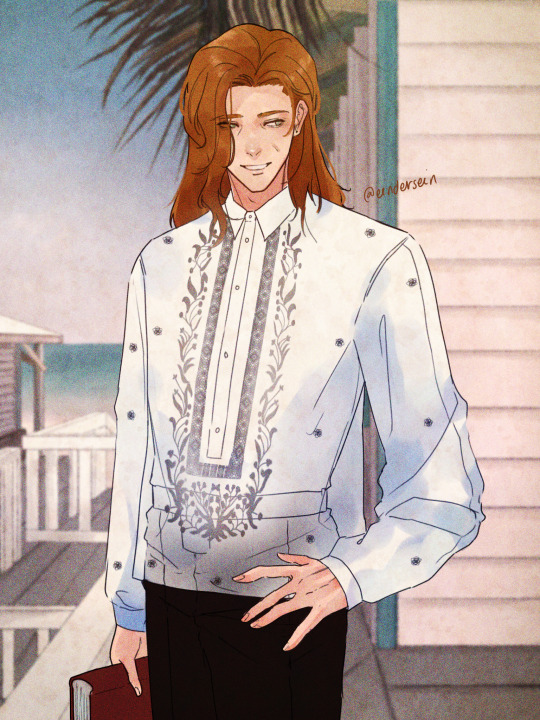
Elliott in Barong Tagalog (A traditional filipino outfit)
#stardew elliott#stardew fanart#ginger#ibispaintdrawing#stardew farmer#digital art#digital painting#stardew valley#painting#fanart#sdv#barong#sdv fanart#sdv elliott#stardew Valley elliott#Filipino culture#filipino#barong tagalog
535 notes
·
View notes
Text
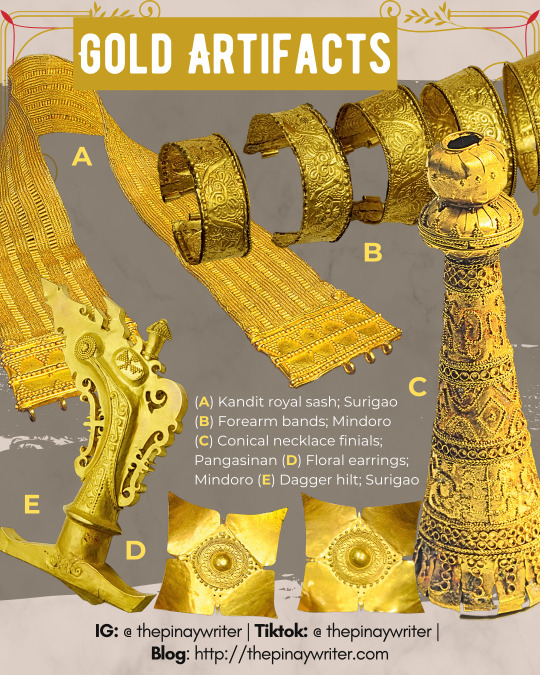

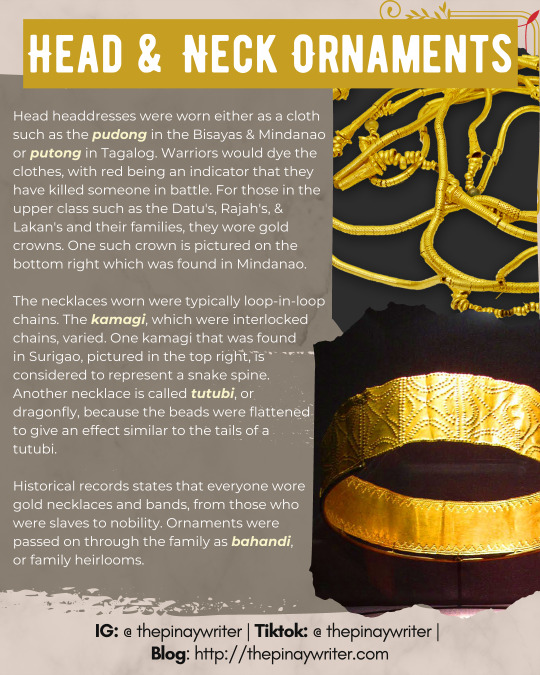
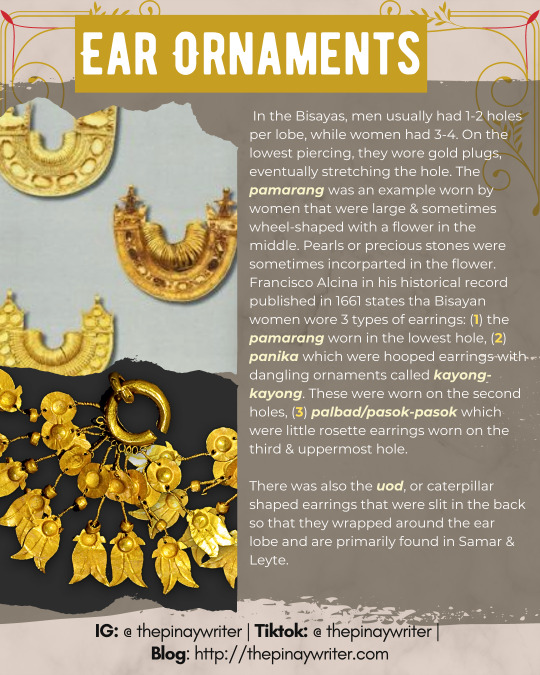

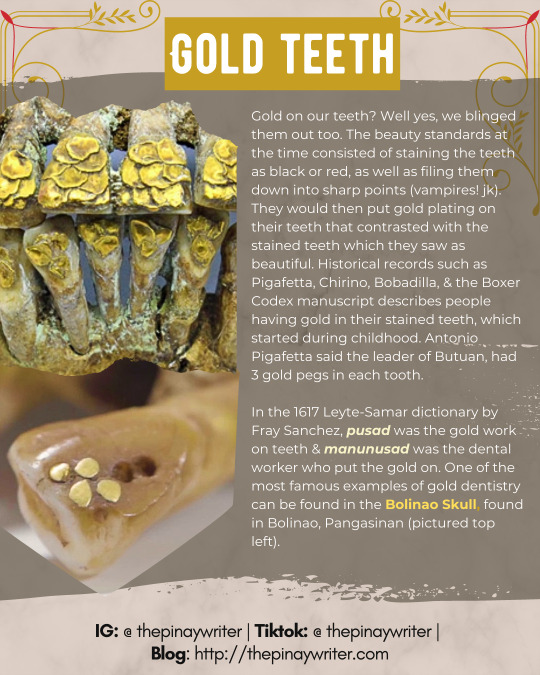


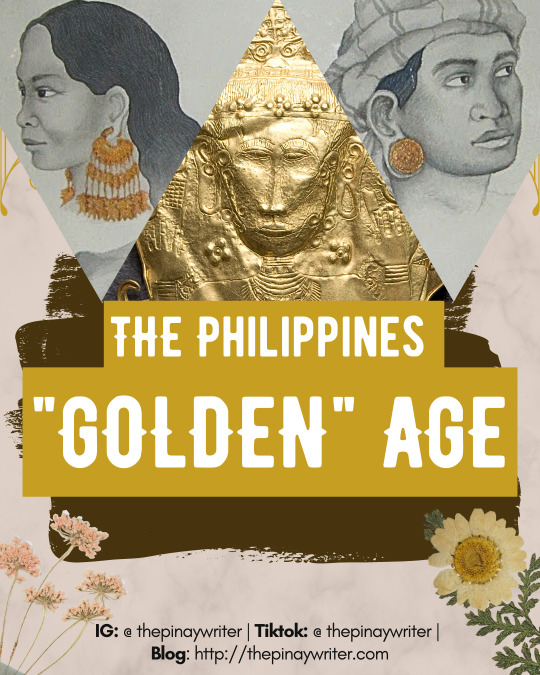
✨️ Our ancestors before the Spaniards arrived wore gold and passed them down through the generations, regardless of social class. They even crafted bowls, liquid vessels, and the hilts and covers of daggers and swords out of gold.
They buried these ornaments with the dead so that they could use it in the afterlife and as a token to give the spirit or deity to leave purgatory. They also covered the faces of the dead with gold death masks to protect them from evil spirits entering the body.
Numerous Spanish accounts record that they wore gold and buried their dead with gold bahandi, or heirlooms. From Antonio Pigafetta, Francisco Alcina, Pedro Chirino, Friar Bobadilla and within the Boxer Codex Manuscript. Together with historical accounts, archeological finds of gold artifacts from Luzon, the Bisayas, and Mindanao show how much our pre-colonial ancestors wore and used gold in their clothing, divine figures, and everyday wear, similar to the rest of Southeast Asia.
To see many of these artifacts, check out the gold exhibit in the National Museum of the Philippines and Ayala Museum.
#filipino#philippines#precolonial Philippines#gold#artifact#history#culture#filipino culture#pinoy#filipino mythology#archaeology
861 notes
·
View notes
Text
So I'd like to talk a bit about the Filipino funeral gold scandal and how as someone writing an anti-colonial Filipino epic fantasy based heavily on early shaman lead rebellions against Spanish colonial rule I have some intense feelings about Filipino actress Beauty Gonzales flaunting wearing funerary death masks taken from a Large number of graves in surigao, butuan and mindinao and rather then treating them with appropriate respect or any kind of cultural ethics and instead turning them into fashion jewelry.
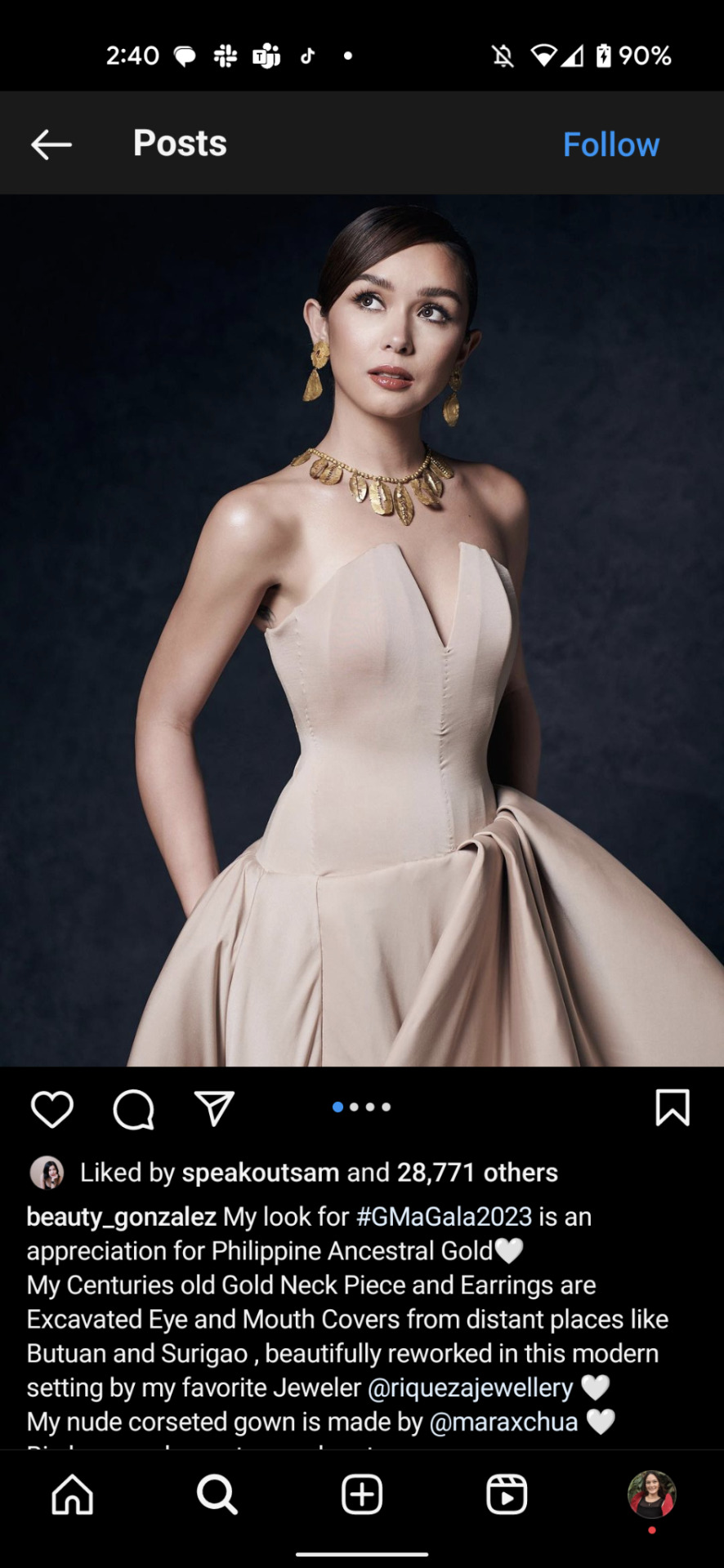
Aside from the damage to important archeological artifacts the utter disrespect shown to the dead who were interred in this way to ensure thier successful passage into the afterlife and to protect their bodies from the entry of evil spirits
For me it calls to mind when I was doing my primary sources research for Saints of Storm and Sorrow into the tree and boat burials of Luzon and reading the accounts of precolonial funerary practices by early Spanish friars and "naturalists" one of these documents was the memoir of Domingo Sanches who in a particularly horrifying account, noted how in the village he was staying in a young girl had died and he recorded how she was mourned and the great love and ceremony with which she was buried and how later that night he snuck back, dug up her grave and stole her body for research purposes. I remember he noted the great hostility of the natives when they discovered his theft and how he'd be unlikely able to return. I can't help being horrified at the thought of a Filipino actress adding to this horrible history of grave robbing and disrespecting the dead. To the colonialist mentality of taking spiritually important items and turning them into decorations. The level of disrespect is staggering. This is not the way to reconnect with our precolonial culture. I'm utterly horrified the more I look at this image and think about all the people who thought this was acceptable

For anyone interested in further reading
News articles citing art and museum critics disapproval
The screenshotted article with snippets from the Spanish naturalists memoir
History of funerary death masks and thier significance
#saints of storm and sorrow#Philippines#filipino#filipino culture#history#fashion#scandal#cultural artefacts#writing research#archaeology#colonialism#filipino history#filipino fashion#filipino author#grave robbery
158 notes
·
View notes
Text
Painting a picture of the history of Filipino Tattoos
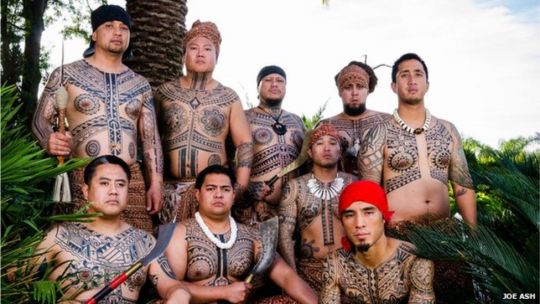
A photo of tattooed Filipino men posted on BBC and accredited to Joe Ash
Tattoos are often seen as integral cultural symbols in my different societies whether it be seen as something honorable or dishonorable. Even in the most straight-laced cultures, a tattoo acts as a mark of some form of the person's history and their standing in their communities as well as how people perceive them.
In a lot of modern cultures, the tattoo often have negative connotations, often associated with delinquency or criminal activity. Historically, however, they may have grander and more honorable significance in different societies. The communities that had existed in the Philippines prior to contact with Spain fits this similar pattern.
Before I start
As usual, the Philippines is a diverse country that has different traditions and histories that come from different ethnic groups and states, only being first unified under a government by colonization. Because of this, this post will only be able to cover parts of this culture and may not be able to fully encompass all Filipino traditions, practices, and beliefs about tattoos.
This is also given the fact that more specific information may be harder to come across or may not exist at all in a space I could easily access.
That being said, the general term for Filipino traditional (both precolonial and current) tattoo practices is batok, batik, patik, or patek depending on language or culture. It is also known as buri or burik in several other groups and languages. This word, however, isn't often used for typical tattooing in most modern communities.
The History
From a general understanding of a lot of precolonial Southeast Asian cultures, it can be assumed that precolonial Filipino societies heavily valued tattoos as their neighboring maritime SEAsian countries also had prior to the introduction of Abrahamic religions to the region which often discouraged or even forbade tattooing the skin.
Although this can be assumed, there were no known precolonial description nor record of these tattoos during the actual time period before Spanish contact. There is evidence found in some burial sites however, as discussed by social anthropologist Salvador-Amores in her paper The Recontextualization of Burik (Traditional Tattoos) of Kabayan Mummies in Benguet to Contemporary Practice (2012). In the paper, she focuses a section on the history of burik by explaining the Kabayan Mummies or the Fire Mummies of Benguet, Mountain Province.
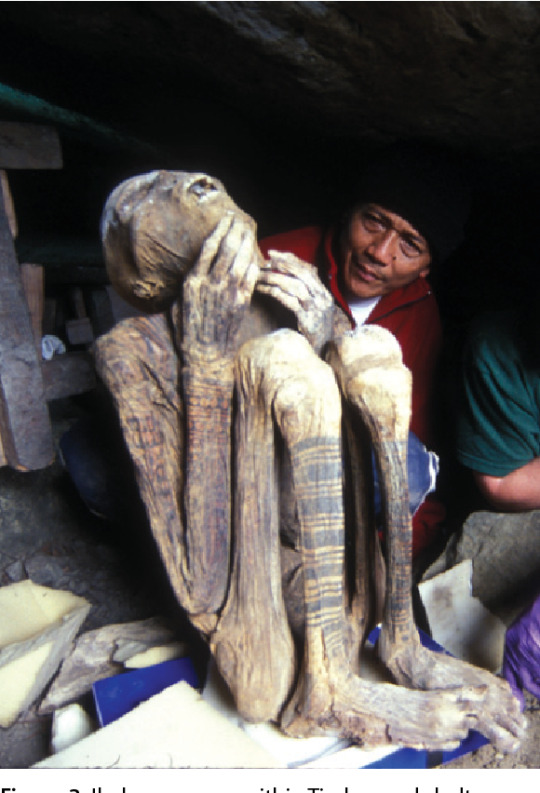
An image of one of the Kabayan Mummies uploaded by Dario Piombino-Miscali on ResearchGate.net
These remains had been dated back to the 13th century and are associated with the Ibaloi, an indigenous ethnic group from Mountain Province found in the northern parts of the island of Luzon. This does confirm that tattooing had been important to the people who had lived in this area during this time period as, in Salvador-Amores's paper, it can be noted that the tattooed mummies seem to be prominent with the adults.
I do have to note that the Ibaloi people, who are part of the larger Igorot ethnic group, were not fully colonized by the Spaniards and therefore does not share the similar Hispanic culture and history that a lot of Filipino groups have. They had only fully been integrated into the Philippines during the American colonial period where they and the other Igorots had been properly colonized by American and placed under the rule of the American-controlled Filipino government. (x)
Regardless, this does show that at least some cultures in the archipelago held tattoos with high importance and did not consider them as something negative compared to the modern perception of tattoos.
The first known illustration of tattooed Filipinos, however, was first seen in the Boxer Codex (circa 1590) during the early Spanish colonial period, written and illustrated by an unknown author.
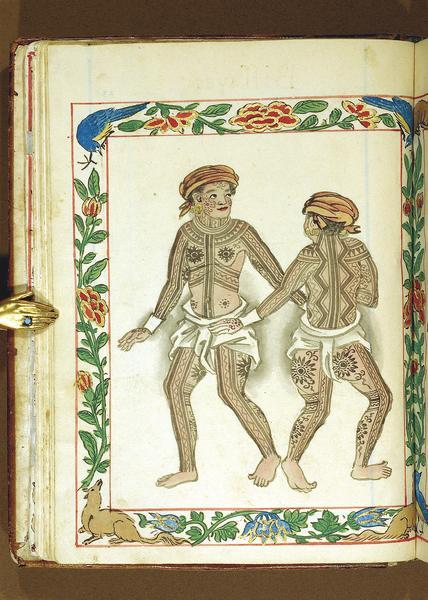
A page from the Boxer Codex (circa 1590), author uknown
This illustration seems to be that of the specific ethnolinguistic group, the Visayans as this page is next to another one labeled as "Biſſaya", a likely earlier spelling of Bisaya that uses the long s (ſ). This aligns with the description given as early as Antonio Pigaffatta, Ferdinand Magellan's chronicler, who consistently describes the Visayans that he has met as painted in his account of their arrival in the islands back in 1521.
The book The Philippine Islands 1493-1898 Vol. XII has compiled different first-hand and second-hand sources about the Philippines during the 15th through 19th century, with Vol. XII focusing on the early 17th century which aligns closely to the Boxer Codex. Within the text, there are several mentions of the "Pintados" or the Painted ones, even having an entire province be called the "province of Pintados".
It isn't made clear who the Pintados are besides the fact that they seem to be hostile towards the Spanish colonizers and had often fought battles with one of the letters even claiming that they had poisoned one of the Spaniards. It isn't until we reach the last part of the compilation which features Pedro Chirino's Relacion de las Yslas Filipinas which I had a hard time finding before but had now found a free and accessible copy. Within Chirino's writing, he explains that the Pintados seem to be a name given by the Spaniards to the Bisayans and further explains it as such:
"The people of the Bisayas are called the Pintados, because they are actually adorned with pictures --not because this is natural to them, although they are well built, of pleasing countenance, and white; but because they adorn their bodies with figures from head to foot, when they are young and have sufficient strength and energy to suffer the torment of the tattooing; and formerly they tattooed themselves when they had performed some act of valor."
Chirino even gives an explanation as to how precolonial Visayans tattooed their skin:
They tattoo themselves by pricking the skin until the blood comes, with sharp, delicate points, according to designs and lines which are first drawn by those who practice this art; and upon this freshly-bleeding surface they apply a black powder, which is never effaced. They do not tattoo the body all at the same time, but by degrees, so that the process often lasts a long time; in ancient times, for each part which was to be tattooed the person must perform some new act of bravery or valiant deed
It is notable, however, that not only did the Spanish not mention any tattoos on other Filipino groups such as the Tagalogs, but a lot of the illustrations in the Boxer Codex do not sport any tattoos at all which makes it confusing as to when had tattoos faded out of cultural significance in these other communities, likely even before Spanish contact.
Lane Wilcken, a researcher who studies the history of tattoos from the Philippines and the Pacific Islands, writes in his book Filipino Tattoos: Ancient to Modern (2010) that it may be possible that the Tagalogs may had lost their tattooing traditions shortly before Spanish contact during the recent islamization of their communities circa 1500 which was and specifically in the polity of Maynila. This may also be the case for the Moros which is a muslim ethnolinguistic group found in the island of Mindanao.
Either way. tattoos became more scarce within Filipino records after the arrival of the Spanish and the introduction of Christianity to the islands, save for some indigenous groups that were not fully colonized by Span like previously mentioned Igorot people.
Because of the spread and dominance of Christian and Islamic customs throughout the country, Batok, as it originally was, was lost to time with the lack of existing artists and cultural relevance tattoos. Tattoos didn't come back to the Filipino mainstream until modern tattoos became more prevalent especially in the mid to late 20th century, similar to its rise in popularity in Western cultures, and even then, it wasn't really what I would consider any traditional and is often negative.
Present Day
Like a lot of other countries, however, tattoos had seen a swing of opinion and is more accepted now as an art form rather than a sign of criminal activity but some stereotypes are still popular.
For instance, during the COVID-19 lockdown, the Department of Education provided modules for students to answer at home which would be then collected by the school from door to door. In one of these modules, Lea Salonga, a Filipino singer, complained on November 17, 2020 on her Facebook page of a discriminatory question that was found in one of the modules, pictured below
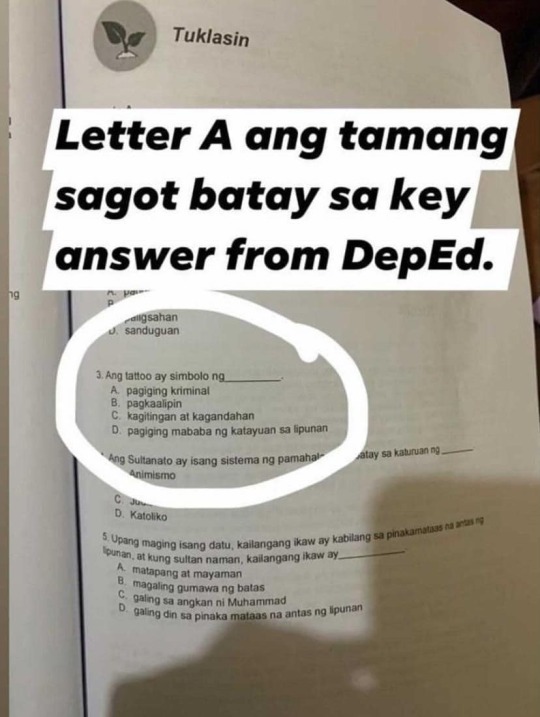
EN Translation:
White text: The answer is letter A based on the DepEd answer key.
Module text:
3. Tattoos are a symbol of _____
A. being a criminal
B. being a slave
C. courage and beauty
D. having a low standing in society
This controversy caused an uproar online and showed that there are a lot of Filipinos today that don't see a problem with tattoos and even see them as a positive. Two days after the image was posted on Salonga's page, the Department of Education publicly recognized the misstep and had issued that they officially recognized the controversial answer as an error.
It is important for me to note that, just like in a lot of countries, tattoos are typically not accepted in the corporate world and those who have them either have to get them removed or at least cover them up if they get hired at all. There's still a common idea that people with tattoos, if not dangerous, may be seen as unprofessional or even unclean which I do know is a similar thing that other countries may have as well.
As for batok, its comeback in the larger Filipino mainstream didn't return until some time in the late 2000s and 2010s when more international influence had resparked and interest in more ethnic cultures including the precolonial Filipino tattoos specifically because of the internet and the rise of social media. The current batok that we see outside of indigenous communities could be seen as a recreation of the extinct practices within the Philippines with some level of appropriation from related cultures (by appropriation, I mean this in a neutral way not a negative one).
It is argued whether or not the reconstructed practice could be considered traditional at all, but considering its heavy emphasis on the older designs found in historical illustrations as well as designs from indigenous communities that did not have practice eradicated by colonization, some also argue that the modern tattoos that has gained prominence because of modern technology and research is still valuable in a socio-anthropological sense.
As Salvado-Amore puts it
the successive phases and changes in the status of burik tattoos—enabled by the advent of modern technology, the Internet, and mass media—encourage an interaction between contemporary and historical influences rather than an extinction of past practice.
About Apo Whang-Od
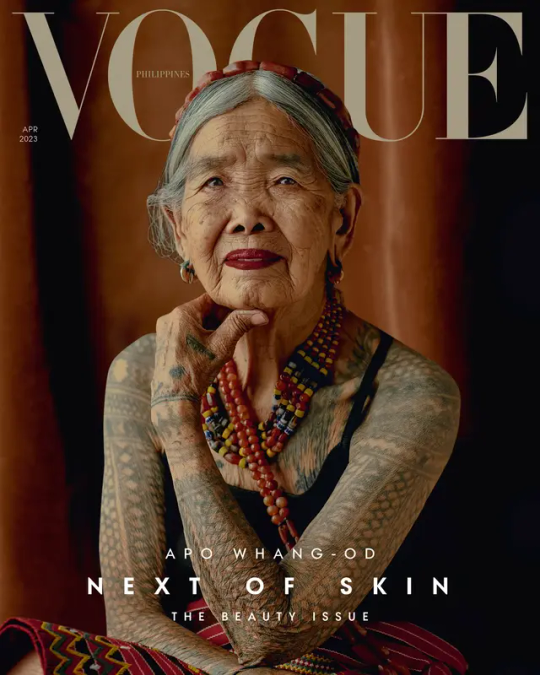
A magazine cover of Vogue featuring Whang-Od, a traditional tattoo artist from the Butbut people, a subgroup within the Kalinga ethnic group. (The rest of this section pulls from the same article by Vogue)
Any research about Filipino tattoos, especially in the modern day would be incomplete without any mention of Whang-Od, the most popular traditional tattoo artist from the Philippines.
Apo Whang-Od (b. February 17, 1917, a.k.a. Maria Oggay) is a member of the Butbut people of the Kalinga indigenous ethnic group from Kalinga province, Philippines. She is often known as one of the last mambabatok in the country which earned her fame and recognition internationally. She started her tattooing practice since she was a teenager at age 16, under the mentorship of her father and was the only known female mambabatok during her time.
For years, she was called on by different communities within her locale in order to tattoo important and symbolic tattoos on members of her and different communities after they had received certain milestones. Men were tattooed for different reasons than women as men were given their marks when they succeed in activities like headhunting, which was ritualistically important for the Butbut people while women were tattooed for reasons like fertility or beauty.
Because of American colonization, however, headhunting was prohibited so she was mostly tattooing women from then onward.
She started gaining recognition some time in the mid-2000s to the 2010s after she started serving foreign tourists, although she doesn't give them the more traditional symbols. Non-members of the group are given a set of tattoos that she could tattoo on anyone without any strong connection to the original meaning of the art.
Since tattooing was passed through family and Whang-Od herself didn't had any children, she was known as the last mambabatok for a time which caused concern for the extinction of the practice as she was already in her 90s when she gained notoriety, but she has since started training her grandniece Grace Palicas and later on her other grandniece Elyang Wigan and the two, who are now in their 20s, has since helped their great aunt dealing with their clientele.
Due to her fame, she is often the subject of foreign media and interest, even being invited by Vogue magazine to pose for one of their covers (pictured above) and is now known as the oldest Vogue cover model earlier this year at the age of 106.
Despite her fame and arguably cultural importance to not only the Kalinga people but the Philippines as well as online petitions since the 2010s to give her the recognition, she is not eligible to receive the National Artist award— one of the highest awards given to artists of most artistic fields of which only 81 people had received. Victorino Manalo, Chairman of the National Commission for Culture and Arts (NCCA) explains that this is because her craft, tattooing, isn't covered by the NCCA but by the Gawad sa Manlilikha ng Bayan (GAMBA, en. Award for Crafters/Creatives of the Nation) but there has been some discussion within the commission about this issue which still ended with her being denied. In light of this, she is now currently on the running to possibly receive the GAMBA award.
She has an online presence managed by others and she can be found via Facebook and Instagram.
Tattoos now, from my experience
As I had said before, tattoos these days are not as negatively seen as they were in the 20th century and had received a more positive reputation thanks to the rise of its social experience due to the internet and social media's prevalence in the country. As an art student, in fact, it's wasn't that surprising when I learned that one of my classmates had a tattoo and it was even a full sleeve! Now, as least three had tattoos before they graduated with one of them actually being a close friend of mine who's planning to get more despite their parents' disapproval.
Despite this, I still do have people in my life right now that see tattoos as undesirable and unclean, with stereotypes still being prevalent. I had once heard people speak of them in such a negative way but then make an exception for the artsy type of people? It's odd.
As for batok or batik, I had not seen a lot of people with these tattoos in my own life and had only seen it through articles and images circulated around by other people who I don't even know. I guess it makes sense as most people who do get tattoos similar to batok or batik often do it in tourist-y places or are foreigners who want to get a piece of Filipino culture on their way out of the country.
Besides more culture-focused people, batik or batok isn't as prevalent as some of these articles might make it seem and most typical Filipinos who don't come from these cultures are more likely to either not have tattoos at all or have similar tattoos to those that you may see in other countries.
Either way, tattoos could be so personal to a person and whether it's something as deeply-rooted to culture like batik or if it's just the names of your favorite K-Pop idol, that tattoo is important and has special meaning. Get whatever tattoo that you want or don't if you don't want any at all!
#mayaposts#mayapino#philippines#filipino#philippine history#philippine culture#filipino culture#filipino tattoos#philippine tattoos#history#culture#tattoos#apo whang-od#whang-od#mummy#mummies#death#long post#very long post
75 notes
·
View notes
Video
Any VALORANT players among my followers?
I’m not much of a fanart person, but I knew I had to make one of Neon depicting her in her hometown Manila. As you probably already know, cultural representation is very important to me, which is why I’m glad that Neon was added into the game (even if I’m not a Duelist player).
This is not only fanart for a video game, but also an expression of Filipino cultural art. How much of Manila’s architecture and other local details can you recognize?
Play it - it’s a looping animation!
(Baybayin fonts designed by Aaron Amar, Lloyd Zapanta, and myself)
#valorant#fanart#neon#video game#manila#philippines#pinoy art#pinoy culture#filipino art#Filipino Culture#filipino#baybayin#alibata#valorant art#valorant fanart#valorant neon#neon valorant#architecture#digital art#3d animation#3d art#gaming#pilipinas#animation
416 notes
·
View notes
Text
your house when you left your grandkids for a few seconds:

we're making 🇵🇭 art history memes for our history elective class 😭 like and follow our IG page (please help us struggling college students out)
#art history#history#art#painting#paintings#artwork#artblr#art history memes#filipino art#filipino culture#Juego de Niños by Miguel Zaragoza
58 notes
·
View notes
Text


The Shaved Ice/Tropical Parfait snack item on the Tamagotchi Uni highly resembles a Halo-Halo from the Philippines!
80 notes
·
View notes
Text


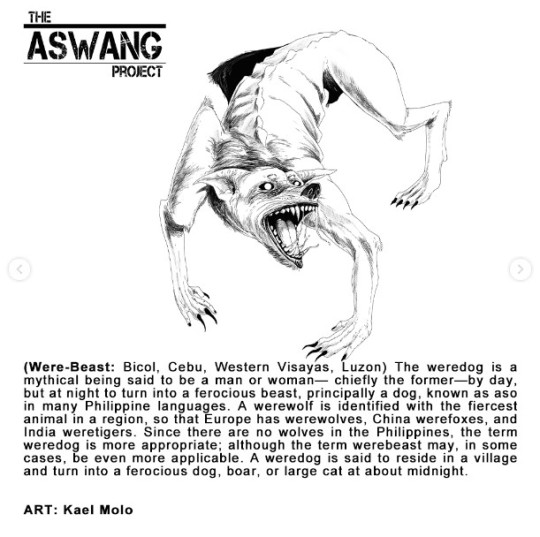
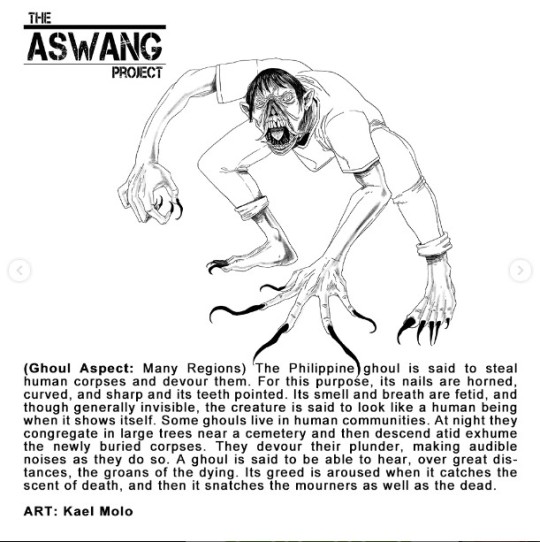


What is an aswang? This is a question that has continually resurfaced during my twenty years of studying the folklore and religious beliefs of the various ethnolinguistic groups in the Philippines. It is a question that so intrigued me, I spent almost five years exclusively exploring the topic, culminating in my documentary The Aswang Phenomenon (2011). It is a question that has confronted many before me, and will hopefully continue to intrigue academic and creative minds into the future. For the Filipino, the answer may seem very simple and concise. They will likely answer the question based on the belief in their community with such certainty and vigor that there is little room for misinterpretation. Moving to the next barangay will elicit a different yet equally assertive answer. Travelling throughout the country leaves one with hundreds of interpretations.
In the 1960s, Dr. Maximo Ramos, affectionately referred to as the “Dean of Philippine Lower Mythology,” undertook the monumental task of creating taxonomical classification of folkloric beings throughout the Philippines. The culmination of this work was eventually published in a book called The Creatures of Philippine Lower Mythology (very recommended). Within its pages, folkloric creatures are neatly placed into twelve categories; Demons, Dragons, Dwarves, Elves, Ghouls, Giants, Merfolk, Ogres, Vampires, Viscera Suckers, Were beasts, and Witches. What I found curious was that the aswang appeared in five of these categories; Ghouls, Vampires, Viscera Suckers, Were beasts, and Witches. These became the taxonomic classification for the aswang in Ramos’ later work The Aswang Complex in Philippine Folklore (also recommended).
Ang ,ga larawan at impormasyon ay mula sa opisyal na Instagram account ng Aswag Project.
78 notes
·
View notes
Text
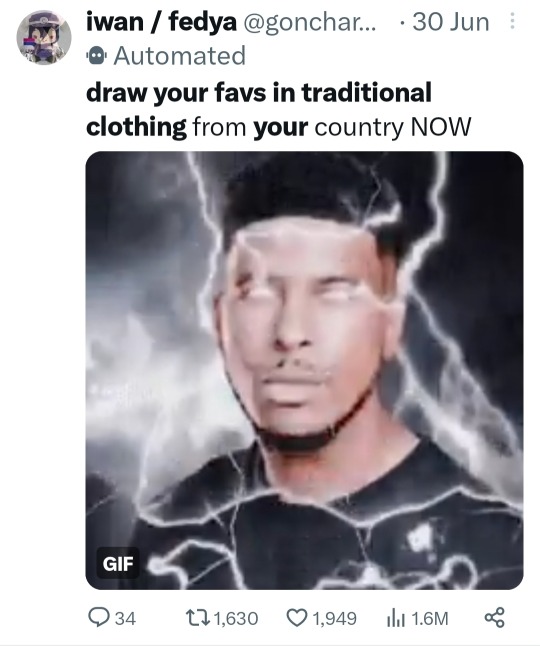
So hi, I saw this post on Twitter and I decided, hey, I wanna do that. So I did.
Below you will see my desperate attempt to reconnect with my culture (through HXH) because God knows I suck at my own mother tongue.

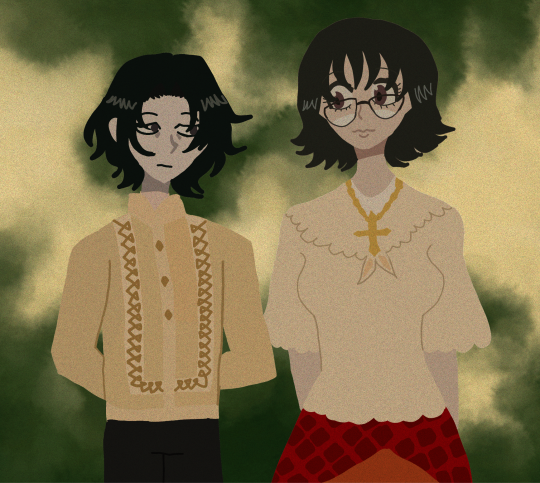
First we have Feitan and Shizuku in Barong Tagalog and Baro't Saya. (I included noiseless and noise version.)

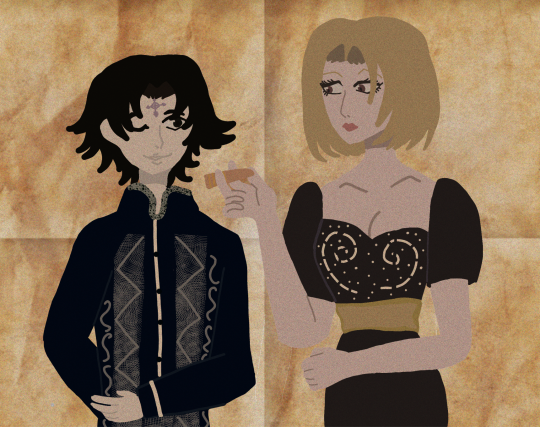
Next, we have Chrollo and Pakunoda in Barong Tagalog (Modernized) and Filipiniana (Modernized as well). I actually based Paku's outfit off a Filipiniana I had in 7th grade.
What Pakunoda is holding is La Campana, a local cigar that is actually produced where I live! Pretty interesting stuff. (I also added the noiseless and noise version).
This is not quite what I was planning to post once November hits but I will get around that big piece (I already finished inking one whole page, 4 to go)! Hope you enjoy!
Before I end this post, my friend @colecxre-17 came up with Filipino names for them for fun:
- Don Felipe 'Feitan' Portugal
- Shiela 'Shizuku' Muñoz
- Christian 'Choochoo/Chrollo' Luchavez
- Pamela 'Pakunoda' Palomares
Okay this is the end of the post, see you on the next one!
#hxh#hunter x hunter#art#artists on tumblr#hxh 2011#feitan portor#shizuku murasaki#chrollo lucilfer#pakunoda#filipiniana#barong tagalog#baro't saya#filipino#philippines#filipino culture#traditional wear#digital art#phantom troupe#hxh chrollo#hxh shizuku#hxh feitan#hxh pakunoda
48 notes
·
View notes
Text
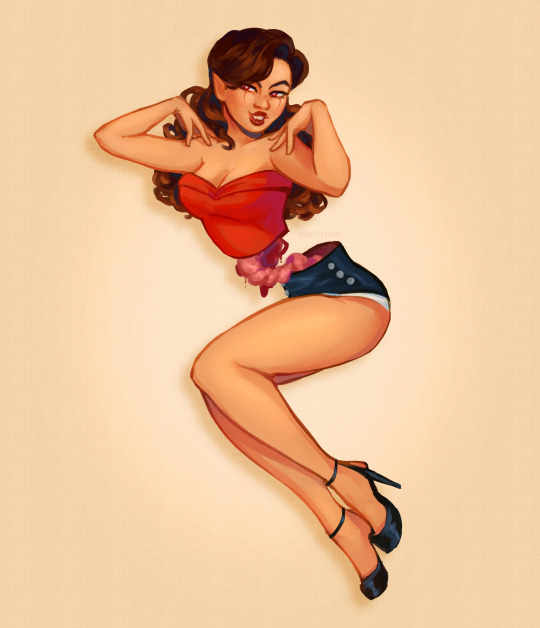
oc art oc art!!
this is kora, my manananggal oc <3 she's a pinup model with a twist ✨
#body horror cw#art#digital art#ocs#oc art#original character#manananggal#filipino oc#filipino culture#character art#character design#digital painting#pinup art#pin up girl#pinup#vampire#vampire art#vampire girl#zeoda
13 notes
·
View notes
Text
Re blog if you’re a religiously traumatised Filipino I’m trying to see something
#filipino#philippines#philippine culture#filipino culture#filipino american#pinoy#religion#christianity#catholic#Christian#Catholicism#ex catholic#ex christian#religious trauma
107 notes
·
View notes
Text
Radio Drama Revival: Hi Nay

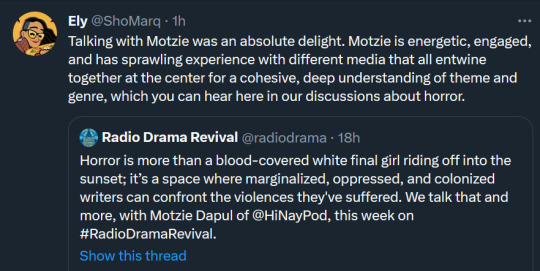
Big thank you for the feature, Ely! This was a treat, and an enormously fun interview. I loved getting to be on @radiodramarevival Radio Drama Revival, and I hope this isn't the last time we get to chat like this 😊
(please note the warnings at the beginning! There's mention of parental physical violence / corporal punishment)
I chat about Hi Nay, my career in animation, why animators/visual artists LOVE podcasts, funny fun facts about horror sound effects, and Filipino Realities and all the gorey details.
And of course

🔊Come listen to the interview!🔊
🌺And come support Hi Nay by joining our fundraiser!🌺
#Radio Drama Revival#Hi Nay Podcast#Hi Nay#Radio Drama#audio drama#podcast#interview#filipino culture#fuck marcos
100 notes
·
View notes
Text
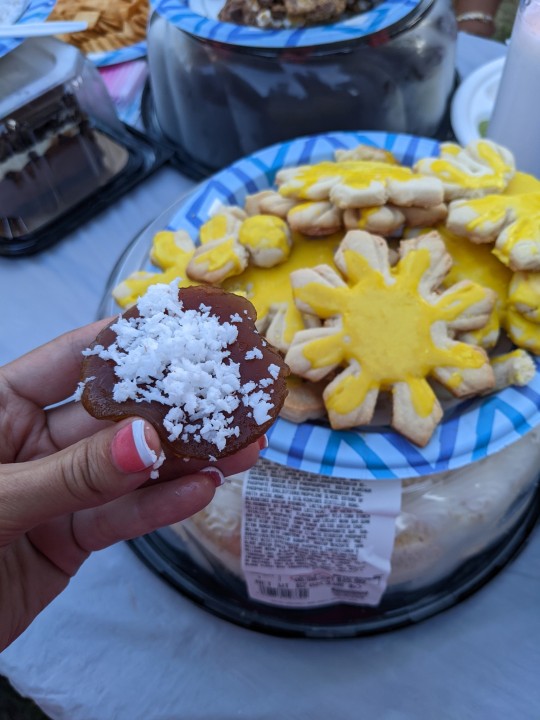
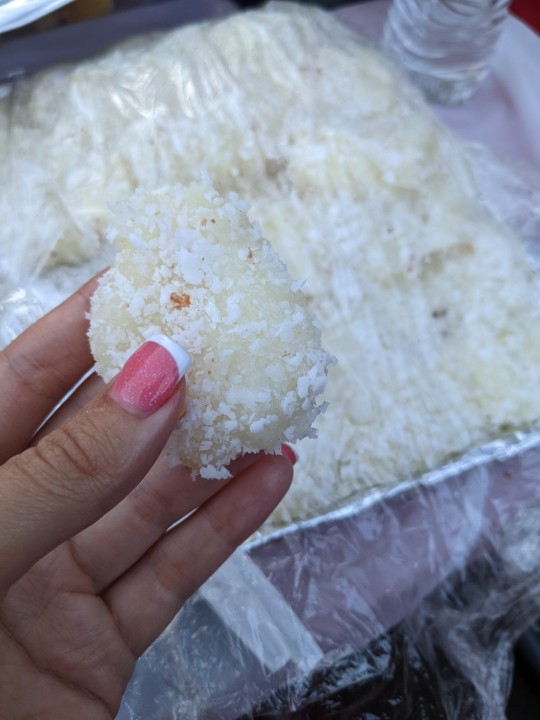
Different kakanin (rice cake) deserts at my big fat Filipino reunion.
A core memory is being the same height as a wedding banquet table and walking off with handfuls of palitaw to gorge on as a kid
My favorite is the white palitaw made with pounded sticky rice or mochi flour but the kutsinta, the brown rice cake was also delicious, it has an amazing chewy texture. Both are coated in fresh grated coconut 🥥
If you're interested in recipes, this month's newsletter will include my Lola Inday's Palitaw recipe just sign up on my author website !
63 notes
·
View notes
Text
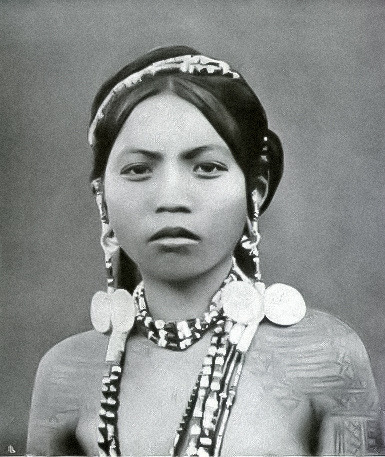



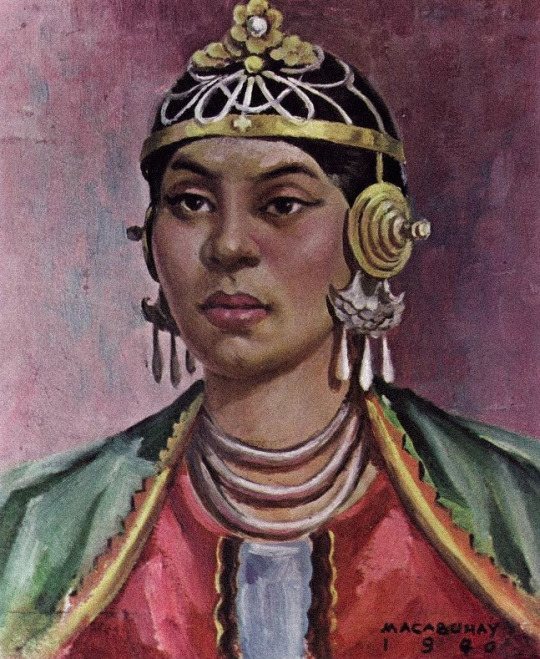
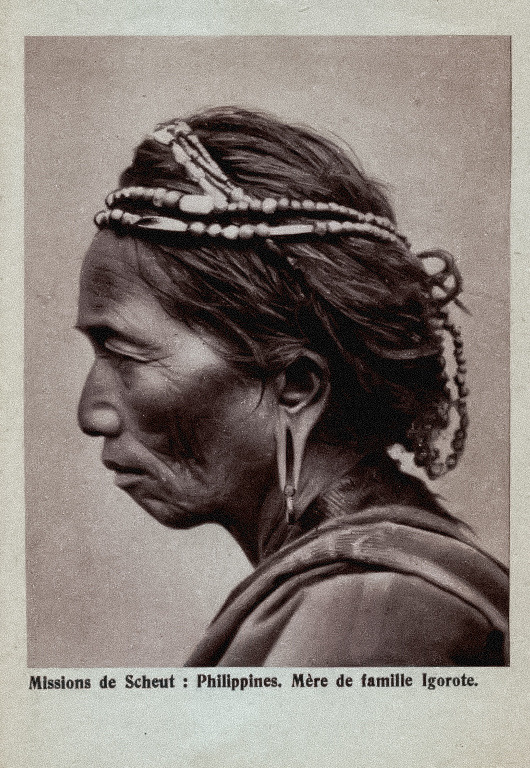
“It's in our blood to adorn ourselves with tattoos and embroidery, beads and gold.”
(Stephanie Gancayco, ‘Hella Pinay’ — 28/03/2017)
#venuscore#philippines#precolonial philippines#filipino culture#filipino#pinay#indigenous#tattoos#gold jewelry#painting#archeology#history#feminism#moodboard
10 notes
·
View notes
Text
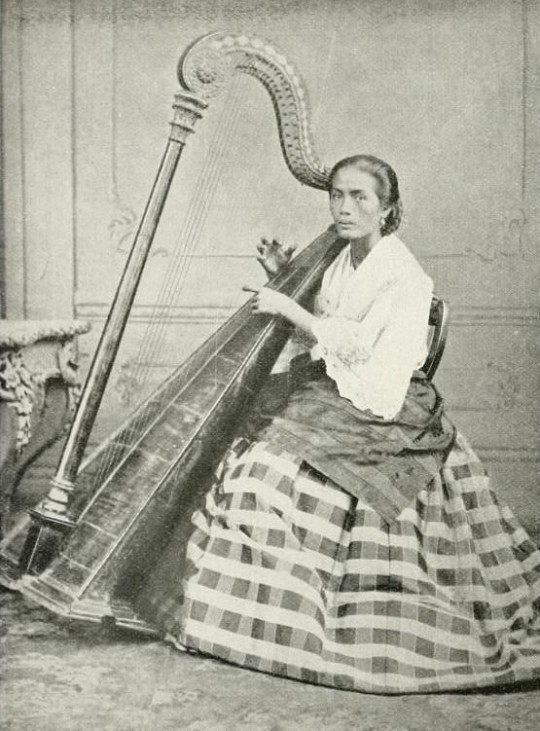
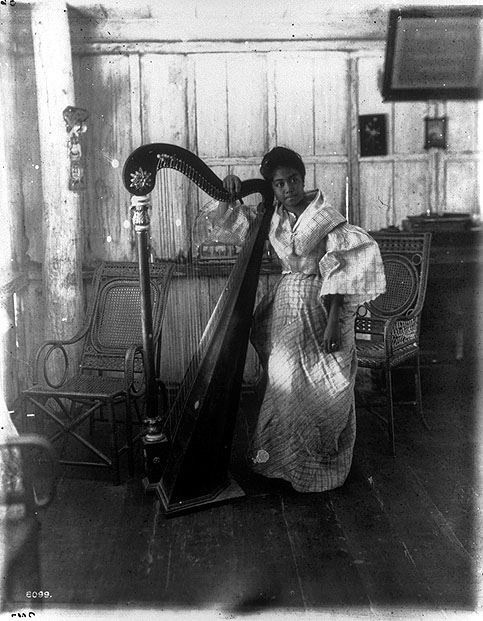


old photos of Filipinas with harps! (mentally, this is where I am)
#for nyo philippines#hetalia#hws philippines#hetalia world stars#ヘタリア#vintage#filipiniana#fashion#filipino fashion#filipino culture#harps#traje de mestiza
116 notes
·
View notes
Text
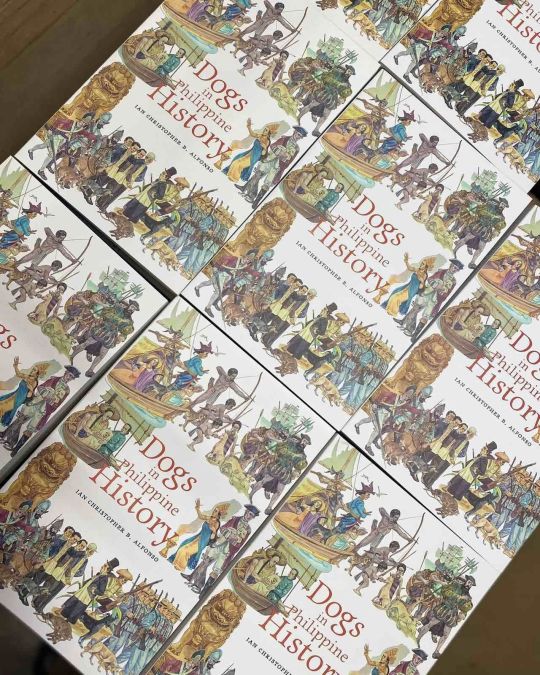
Dogs in Philippine History by Ian Christopher Bermudo Alfonso chronicles the Filipinos’ cultural and historical encounters with dogs since the earliest documented existence of a domesticated dog in the Philippines about 4,000 years ago. It hopes to be of help in understanding Filipino culture and in fostering responsible furrenthood. History attests to how our culture loves dogs.
You can order a copy through this link (for Philippine residents only) or find out more about the book through its Facebook Page.
32 notes
·
View notes